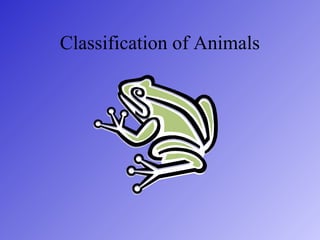
Animal classification vertebrates 5th grade
- 3. Animals With Backbones • Animals with backbones are called vertebrates. • Vertebrates include many different kinds of animals. They can be found just about everywhere – in oceans, rivers, forests, mountains, and deserts. • Animals with backbones can be broken up into smaller groups by characteristics. • They are:
- 4. Fish
- 5. Fish Characteristics • They are the largest group of vertebrates. • Fish have a head, an elongated body and a tail. Many fish are covered with scales that protect them. • They have fins that help them to steer and balance in the water. • Their body temperatures vary in the water. • They breathe through gills which enable them to breathe underwater. They can extract dissolved oxygen from water • Fish are oviparous. Female fish lay their eggs in the water. Baby fish, called fry, hatch from eggs.
- 6. Fish parts
- 7. Fish Groups Fish can be classified into 2 groups: • Cartilaginous fish: their skeleton is made of cartilage. Most are marine, like shark and rays. • Bony fish: the skeleton is made of bones. Some live in the sea and some others in lakes and rivers, like sardines, carps, salmon
- 8. Amphibians
- 9. Amphibian Characteristics • When they are born they are aquatic larvae or tadpoles. They breath through gills and move with the tail. • As the larvae grow, their appearance changes. They lose their gills and develop lungs to breath. They lose their fins and develop 4 legs to move on land. This is the metamorphosis
- 10. Amphibian Characteristics • Amphibians’ skin has no protective covering. They live on land but they stay in or near water to keep their skin moist. If their skin dries out, they die. • Amphibians are oviparous. The female lays eggs in water, but they don’t take care of them. • Most amphibians are carnivorous. They feed on insects and invertebrates.
- 11. METAMORPHOSIS
- 12. Amphibian Groups Amphibians can be classified into 2 groups: 1. Amphibians without tail: they have a short body and long, strong legs which are good for jumping. They catch their prey with their tongue: it is long and extends rapidly, like in frogs and toads
- 13. Amphibian Groups 2. Amphibians with tail: they have a long body and 4 limbs. All four limbs are approximately the same length. Typical examples are salamanders and tritons
- 14. Reptiles
- 15. Reptile Characteristics • Reptiles have a head, a trunk, limbs and a tail. Their bodies are covered with hard scales. • Most reptiles are terrestrial, but a few are aquatic. • They need external heat, like heat from the Sun, to maintain their body temperature. That’s why they are called cold- blooded animals • All reptiles breath though lungs. They come to the surface to breath from time to time. • Reptiles are oviparous. • Most reptiles are carnivorous and capture live prey.
- 16. Reptile Groups Reptiles can be classified into 4 main groups: 1. Snakes have long bodies with no limbs. To move, they slither. Most are terrestrial. Some produce venom which they inject into their prey. 2. Lizards are small reptiles. They have long bodies and 4 very short legs. They crawl, like lizards and iguanas.
- 17. Reptile Groups 3. Crocodiles: are very large reptiles. They have 4 legs and a long body covered with hard scales. They use their teeth to capture prey. 4. Turtles: have a shell to protect their body. They can extend their head, legs and tail through openings in the shell. Many turtles are aquatic, but they breath air, and lay eggs on land
- 18. Birds
- 19. Bird Characteristics • Birds are vertebrates that have wings and they are covered with feathers. Birds breath though lungs • Birds can maintain their body temperature constant. They are called warm blooded animals • Female birds lay eggs on land. Male and female birds maintain the temperature of the eggs with their own body heat. This is incubation • All birds are terrestrials. Their mouth is covered
- 20. Mammals
- 21. Mammal Characteristics • All mammals have a head, a trunk and limbs. They breath through lungs and are warm-blooded. • Mammals are the only animals that have a body covered with hair and fur. • Mammals are terrestrials and viviparous because the young develop inside the female’s body.
- 22. Groups of mammals 1. Marsupials: they are very special: when their young are born, they are not very well developed. As a result, they remain in the mother’s pouch until they are more developed. Examples are kangaroos and koalas.
- 23. Groups of mammals 2. Primates: human beings belong to this group. Primates have hands with 5 fingers to hold things. Their eyes are located on the front of the head, not at the sides. Examples: monkeys and gorillas.
- 24. Groups of mammals 3. Other groups of mammals: 3.1. Rumiants: are herbivores and have feet with hooves. Zebra 3.2. Carnivores: hunt for food. They have sharp teeth. Lions 3.3. Bats: the only mammals which fly. Their front limbs are wings.
- 25. Groups of mammals 3.4. Cetaceans: are marine mammals. They have fins, like whales and dolphins. 3.5. Rodents: feed on hard plants., so their teeth are constantly wearing down and growing. Squirrels and rats. 3.6.Insect eaters: feed on insects and invertebrates. They have many small, sharp teeth and use them to catch the prey. Hedgehogs.